Cambodia
Exotic Allure and Cultural Marvels
Cambodia, a Southeast Asian gem, entices visitors with its ancient temples, rich history, and warm hospitality. Retirees seeking a unique blend of cultural immersion, natural beauty, and affordability find Cambodia to be an enticing destination. It's important to note that Cambodia's infrastructure and amenities may vary compared to more developed countries. Retirees should be prepared for different levels of comfort and adaptability during their travels. However, the country's affordability and the genuine hospitality of its people make it an attractive choice for retirees seeking an enriching and budget-friendly travel experience.In this article, we will explore the top destinations in Cambodia that retirees visit and prefer the most, showcasing the highlights and attractions that make each place special.
Siem Reap - The Gateway to Angkor:

Photo by Nathan Twarn / Pixabay |
Siem Reap, the gateway to the awe-inspiring Angkor Archaeological Park, is a must-visit destination for retirees. The magnificent temples of Angkor, including the iconic Angkor Wat, Bayon, and Ta Prohm, offer a glimpse into the ancient Khmer civilization. Retirees can immerse themselves in the intricate carvings, explore the sprawling ruins, and witness breathtaking sunrises and sunsets over these architectural wonders. You can also take a leisurely stroll through the vibrant markets and sample delectable Khmer cuisine, or embark on a tranquil boat ride along the picturesque Tonle Sap Lake to witness the unique floating villages. |
|
For those interested in history, the Angkor National Museum provides valuable insights into the region's past. And if you're looking to unwind, don't miss the chance to indulge in a traditional Khmer massage and spa treatment to rejuvenate your body and soul. Siam Reap truly is a multifaceted destination that promises a memorable retirement adventure |
Phnom Penh - Capital City's Historical Splendor:

Photo by Mohan Nannapaneni / Pexels | As the capital city of Cambodia, Phnom Penh beckons retirees with its blend of history, culture, and modernity. The Royal Palace and Silver Pagoda showcase exquisite Khmer architecture, while the Tuol Sleng Genocide Museum and Killing Fields provide insights into Cambodia's tragic past. Retirees can enjoy strolls along the riverfront, explore bustling markets, and savor delicious Khmer cuisine.
|
Battambang - Tranquil Riverside Charm:
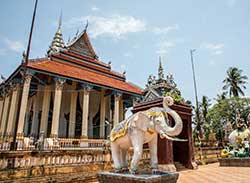
Cesare Palma / Adobe Stock | Battambang, Cambodia's second-largest city, offers a more relaxed and authentic experience for retirees. This riverside town boasts well-preserved colonial architecture, traditional Khmer houses, and a thriving arts scene. Retirees can take leisurely walks along the riverfront, visit the famous Bamboo Train, explore ancient temples like Wat Banan, and witness traditional performing arts at Phare Ponleu Selpak.
|
Kampot - Serene Riverside Retreat:

Photo by Krong Kampot | Nestled along the banks of the Kampot River, Kampot is a peaceful destination favored by retirees seeking tranquility and natural beauty. The town is renowned for its picturesque French colonial architecture, pepper plantations, and the nearby Bokor National Park. Retirees can relax by the river, explore the old town's charming streets, take boat trips to the nearby mangrove forests, and savor fresh seafood at riverside restaurants.
|
Sihanoukville - Coastal Haven:
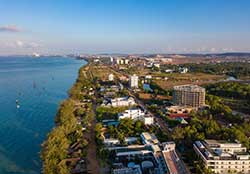
By Umike Foto / Adobe Stock | Sihanoukville, located along Cambodia's stunning coastline, offers retirees an opportunity to enjoy beachside relaxation and water activities. The town boasts beautiful white sand beaches, crystal-clear waters, and vibrant beachside resorts. Retirees can indulge in sunbathing, swimming, snorkeling, or simply unwinding by the sea. Nearby islands like Koh Rong and Koh Rong Samloem provide additional options for island exploration and tranquility.
|
Kep - Coastal Charm and Culinary Delights:
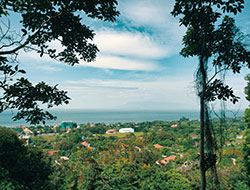
Photo by Souris / Unsplash | Kep, a coastal town renowned for its fresh seafood and relaxed ambiance, is a hidden gem that retirees appreciate. Visitors can explore the quaint Kep National Park, admire the remnants of old French villas, and enjoy the famous crab market. Retirees can savor mouthwatering seafood dishes, take leisurely walks along the promenade, or relax at one of the cozy beachfront accommodations.
|
Cambodia's top destinations offer retirees a unique blend of ancient wonders, cultural heritage, and natural beauty. Whether it's exploring the magnificent temples of Angkor in Siem Reap, delving into the historical significance of Phnom Penh, or seeking serene coastal retreats in Kampot and Sihanoukville, Cambodia has something to offer every retiree.
Travel Planning Tips:
- Visa Requirements: Check the visa requirements for your country of residence before traveling to Cambodia. Most nationalities can obtain a visa upon arrival at the airport or border checkpoints, while others may require an e-visa or visa obtained in advance.
- Best Time to Visit: Cambodia has a tropical climate with two distinct seasons: the dry season (November to April) and the wet season (May to October). The dry season is generally considered the best time to visit, offering pleasant temperatures and minimal rainfall. However, be prepared for crowds, particularly around popular tourist sites.
- Duration of Stay:Plan your stay duration based on the attractions you wish to explore in Cambodia. Consider spending a few days in Siem Reap to fully experience the Angkor temples, and allocate time for Phnom Penh to discover its historical and cultural sites. Additional days can be dedicated to other destinations such as Battambang, Kampot, or the coastal towns.
- Health Precautions:Consult your healthcare provider or a travel health clinic before your trip to ensure you have the necessary vaccinations and medications for Cambodia. It is recommended to be up to date on routine vaccinations, including measles, mumps, and rubella (MMR), and to consider vaccinations for diseases like hepatitis A, typhoid, and dengue fever.
- Currency:The official currency of Cambodia is the Cambodian Riel (KHR). However, the US dollar is widely accepted, and most transactions, especially in tourist areas, are conducted in US dollars. Carry a mix of small denominations in both currencies for convenience.
- Local Customs and Etiquette:Familiarize yourself with local customs and cultural norms to show respect to the Cambodian people. Dress modestly when visiting religious sites, remove your shoes when entering temples or private homes, and be mindful of local traditions and sensitivities.Show respect for Cambodian customs and traditions. Avoid inappropriate behavior, such as pointing at people with your feet or touching someone's head, as these are considered disrespectful in Cambodian culture.
- Travel Insurance: It is highly recommended to have travel insurance that covers medical emergencies and trip cancellations. Ensure that your insurance policy includes coverage for activities such as temple visits, outdoor adventures, and transportation.
Transportation:
- Domestic flights: Domestic flights are a popular and convenient mode of transportation for longer distances in Turkey. Turkish Airlines and other domestic carriers operate frequent flights between major cities and tourist destinations. Domestic flights are generally reliable, time-efficient, and offer a comfortable travel experience.
- Trains: Asia offers a variety of train options, from high-speed trains connecting major cities to scenic train journeys that showcase breathtaking landscapes.
- Local Buses and Taxis: In urban areas, local buses and taxis are commonly used for short-distance travel within cities.
- Tuk-tuks and Rickshaws: In some Asian countries, such as Thailand and India, tuk-tuks and cycle rickshaws provide a unique and fun way to navigate through narrow streets and bustling markets.
Safety Tips:
- Like any travel destination, it is important to take safety precautions in Cambodia. Be cautious of your belongings, particularly in crowded areas, and use secure bags or money belts to prevent theft. Stay hydrated, use sunscreen, and protect yourself from mosquito bites by using repellent and wearing appropriate clothing.
- Travel Insurance: It is highly recommended to have travel insurance that covers medical emergencies and trip cancellations. Ensure that your insurance policy includes coverage for activities such as temple visits, outdoor adventures, and transportation.
- Travel Advisories Stay updated on current events, local regulations, and any travel advisories when traveling abroad. Visit the US Government State Department Travel Advisories web site to check on the status of your destination.
- Enroll in the STEP Program: Travelers are also urged to enroll in the U.S. State Department's Smart Traveler Enrollment Program (STEP) to receive security messages and to make it easier to locate them in an emergency. The Department uses these security messages to convey information about terrorist threats, security incidents, planned demonstrations, natural disasters, etc. In an emergency, please contact the nearest U.S. Embassy or consulate or call the following numbers: 1 (888) 407-4747 (toll-free in the United States and Canada) or 1 (202) 501-4444 from other countries.
| |
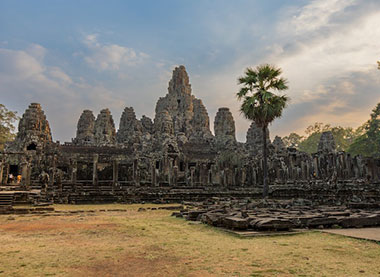 Bayon Temple at Angkor Wat, Siem Reap Photo by Serg Alesenko
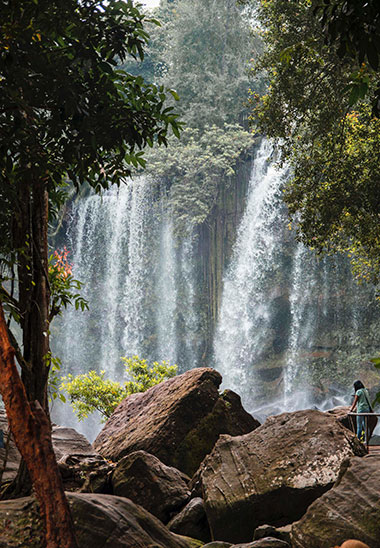
Phnom Kulen National Park, Siem Reap
Photo by Monyserei Ra
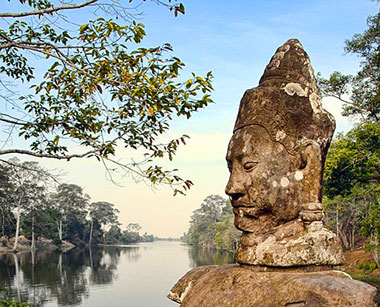 Temple statue, Siem Reap
Photo by Graham Hobster
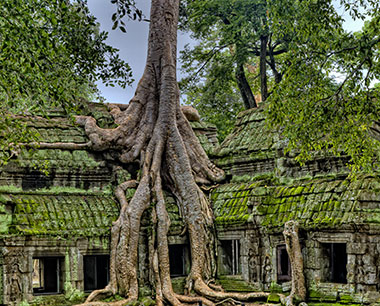 Ancient Siem Reap
Photo by James Wheeler
|
 Bayon Temple at Angkor Wat, Siem Reap
Bayon Temple at Angkor Wat, Siem Reap Phnom Kulen National Park, Siem Reap
Phnom Kulen National Park, Siem Reap Temple statue, Siem Reap
Temple statue, Siem Reap Ancient Siem Reap
Ancient Siem Reap